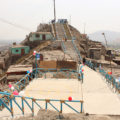Transit Oriented Development study commissioned by the World Bank to assess the potential for urban regeneration processes after the implementation of metro L2 in the Ate – Santa Anita corridor, in the East of Lima. The study comprised three aspects, including urban mobility, sustainability and citizens participation, and focused in the last four stations of […]
Implemented by the Municipality of Lima between 2012 and 2014, Barrio Mío aimed regenerating vulnerable areas of the city through infrastructure projects and support to community-led initiatives. The program implemented risk-mitigation infrastructure, such as contention walls and improved access to slopes, developed participatory strategic plans to stir public investment, and coordinated the deployment of municipal […]
Basic Habitat Conditions program financed by AECID and implemented by NGO CESAL under the agreement to “enhance the living conditions of people living in vulnerable areas, through fostering spatial planning instruments, specifically on habitat conditions, water and sewage, construction and improving of existing infrastructures”. I worked as a junior architect in the team between 2011 […]


